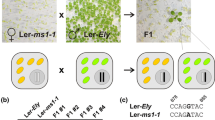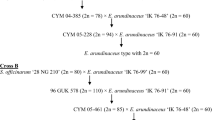Abstract
A series of strains of the homozygous speciesOenothera grandiflora (characterized by the genome BB and plastome III) were combined with plastome IV fromO. parviflora (BC-IV) by means of appropriate crosses. An incompatibility between genome B and plastome IV is expressed in the haplo- and diplophase: (1) B-IV pollen, though normally developed, is largely inactive. The extent of the inactivation varies between different strains and shows a seasonal fluctuation as determined by seed set in outcrossing and selfing experiments. (2) In most of the strains lethality of BB-IV embryos is the rule, leading to empty seeds. This can be ameliorated by including another plastome in the zygotes and developing embryos on account of the biparental plastid transmission inOenothera. It can best be demonstrated in crosses with a seed parent having normal green plastids of plastome IV and mutated chlorophyll deficient plastids from a different plastome in the pollen parent, leading to variegated progeny as well as a remainder of empty seeds. (3) In about one-half of the strains the BB-IV plants exhibit a temporary bleaching of thevirescens type. The incompatibily between genome B and plastome IV does not support the earlier assumption that plastome IV is the ancestor of plastomes II, III, and V. Instead, a precursor plastome is postulated from which plastomes II, III, and IV are descended. While plastome I can be derived from II, only plastome V can be descended from plastome IV.
Similar content being viewed by others
References
Chiu W.-L., Sears B. B. (1993) Plastome-genome interactions affect plastid transmission inOenothera. Genetics 133: 989–997.
Cleland R. E. (1972)Oenothera: Cytogenetics and evolution. Academic Press, London New York.
Dietrich W., Wagner W., Raven P. H. (1997) Systematics ofOenothera sectionOenothera subsectionOenothera (Onagraceae). Syst. Bot. Monogr. 50: 1–234.
Göpel G. (1967) Untersuchungen über die plastomabhängige Pollensterilität beiOenothera. Inaugural-Dissertation Universität Köln.
Göpel G. (1970) Plastomabhängige Pollensterilität beiOenothera. Theor. Appl. Genet. 40: 111–116.
Göpel G. (1976) Stoffwechseländerungen in plastomabhängig inaktiviertem Pollen vonOenothera. Z. Pflanzenphysiol. 78: 411–415.
Harte C. (1994)Oenothera: Contributions of a plant to biology. Springer, Berlin Heidelberg New York.
Hornung S., Fulgosi H., Dörfel P., Herrmann R. G. (1996) Sequence variation in the putative replication origins of the five genetically distinct basicEuoenothera plastid chromosomes (plastomes). Molec. Gen. Genet. 251: 609–612.
Kutzelnigg H. (1968) Versuche zur Auslösung von Plastommutationen beiOenothera. Inaugural-Dissertation, Universität Düsseldorf.
Medgyesy P., Fejes E., Maliga P. (1985) Interspecific chloroplast recombination in aNicotiana somatic hybrid. Proc. Natl. Acad. Sci. USA 82: 6960–6964.
Raven P. H., Dietrich W., Stubbe W (1979) An outline of the sytematics ofOenothera subsect.Euoenothera (Onagraceae). Syst. Bot. 4: 242–252.
Renner O. (1916) Die tauben Samen derOenothera. Ber. Deutsch. Bot. Ges. 34: 858–869.
Renner O. (1919)Oenothera Lamarckiana und ihre Bedeutung für die Mutationstheorie und für die Bastard-forschung. Sitzungsber. Ges. Morphol. Physiol. München 31: 1–6.
Renner O. (1942) Über das Crossing-over beiOenothera. Flora 136: 117–214.
Schötz F. (1954) Über Plastidenkonkurrenz beiOenothera. Planta 43: 182–240.
Schötz F. (1958) Beobachtungen zur Plastidenkonkurrenz beiOenothera und Beiträge zum Problem der Plastidenvererbung. Planta 51: 173–185.
Schötz F. (1974) Untersuchungen über die Plastidenkonkurrenz beiOenothera. IV. Der Einfluβ des Genoms auf die Durchsetzungsfähigkeit der Plastiden. Biol. Zentralbl. 93: 41–64.
Schötz F. (1975) Untersuchungen über die Plastidenkonkurrenz beiOenothera. V. Die Stabilität der Konkurrenz-fähigkeit bei Verwendung verschiedenartiger mutierter Testplastiden. Biol. Zentralbl. 94: 17–26.
Schumacher E., Steiner E. (1993) Cytological analysis of complex-heterozygotes in populations ofOenothera grandiflora (Onagraceae) in Alabama. Plant Syst. Evol. 184: 77–87.
Schumacher E., Steiner E., Stubbe W. (1992) The complex-heterozygotes ofOenothera grandiflora L'Her. Bot. Acta 105: 375–381.
Sears B., Stoike L. L., Chiu W.-L. (1996) Proliferation of direct repeats near theOenothera chloroplast DNA origin of Replication. Molec. Biol. Evol. 13: 850–863.
Steiner E. (1956) New aspects of the balanced lethal mechanism inOenothera. Genetics 41: 486–500.
Steiner E. (1957) Further evidence of an incompatibility allele system in the complex-heterozygotes ofOenothera. Amer. J. Bot. 44: 582–585.
Steiner E., Stubbe W. (1984) A contribution to the population biology ofOenothera grandiflora L'Her. Amer. J. Bot. 71: 1293–1301.
Steiner E., Stubbe W. (1986)Oenothera grandiflora revisited: A new view of its population structure. Bull. Torrey Bot. Club. 113: 406–412.
Stubbe W. (1953) Genetische und cytologische Untersuchungen an verschiedenen Sippen vonOenother suaveolens. Z. Indukt. Abstammungs-Vererbungsl. 85: 180–209.
Stubbe W. (1955) Erbliche Chlorophylldefekte beiOenothera. Photogr. Wiss. 4: 3–8.
Stubbe W. (1958) Dreifarbenpanaschierung beiOenothera. II. Wechselwirkung zwischen Geweben mit zwei erblich verschiedenen Plastidensorten. Z. Vererbungsl. 89: 189–203.
Stubbe W. (1959) Genetische Analyse des Zusammenwirkens von Genom und Plastom beiOenothera. Z. Vererbungsl. 90: 288–298.
Stubbe W. (1960) Untersuchungen zur genetischen Analyse des Plastoms vonOenothera. Z. Bot. 48: 191–218.
Stubbe W. (1963) Extrem disharmonische Genom-Plastom-Kombinationen und väterliche Plastidenvererbung beiOenothera. Z. Vererbungsl. 94: 392–411.
Stubbe W. (1964) The role of the plastome in evolution of the genusOenothera. Genetica 35: 28–35.
Stubbe W. (1970) DasFalcifolia-Syndrom der Oenotheren. 1. Mitteilung. Molec. Gen. Genet. 106: 213–227.
Stubbe W. (1980) Über die Bedingungen der Komplexheterozygotie und die beiden Wege der Evolution komplex-heterozygotischer Arten beiOenothera. Ber. Deutsch. Bot. Ges. 93: 441–447.
Stubbe W. (1989a) Thefalcifolia syndrom ofOenothera. III. The general pattern of its non-Mendelian inheritance. Molec. Gen. Genet. 218: 499–510.
Stubbe W. (1989b) Thefalcifolia syndrom ofOenothera. IV. Loss offalcifolia-determining factors. Molec. Gen. Genet. 218: 511–515.
Stubbe W. (1989c)Oenothera — An ideal system for studying the interactions of genome and plastome. Pl. Molec. Biol. Reporter 7: 245–257.
Stubbe W., Raven P. H. (1979a) A genetic contribution to the taxonomy ofOenothera sect.Oenothera (including subsectionEuoenothera, Emersonia, Raimannia andMunzia). Plant Syst. Evol. 133: 39–59.
Stubbe W., Raven P. H. (1979b) Genetic self-incompatibility inOenothera subsect.Euoenothera. Science 204: 327.
Stubbe W., Pietsch B., Kowallik K. V. (1978) Cytologische Untersuchungen über väterliche Plastidenvererbung und plastomabhängige Degeneration der Samenanlagen bei einemOenothera-Bastard. Biol. Zentralbl. 97: 39–52.
Wasmund O. (1984) Genetische und zytologische Untersuchungen an verschiedenen Sippen vonOenothera nutans Atkinson. Inaugural-Dissertation, Universität Düsseldorf.
Wasmund O., Stubbe W. (1986) Cytogenetic investigations onOenothera wolfii (Onagraceae). Plant Syst. Evol. 154: 79–88.
Wolfson R., Higgins K. G., Sears B. B. (1991) Evidence for replication slippage in the evolution ofOenothera chloroplast DNA. Molec. Biol. Evol. 8: 709–720.
Author information
Authors and Affiliations
Additional information
Deceased August 28, 1998.
Rights and permissions
About this article
Cite this article
Stubbe, W., Steiner, E. Inactivation of pollen and other effects of genome-plastome incompatibility inOenothera . Pl Syst Evol 217, 259–277 (1999). https://doi.org/10.1007/BF00984370
Received:
Accepted:
Issue Date:
DOI: https://doi.org/10.1007/BF00984370




